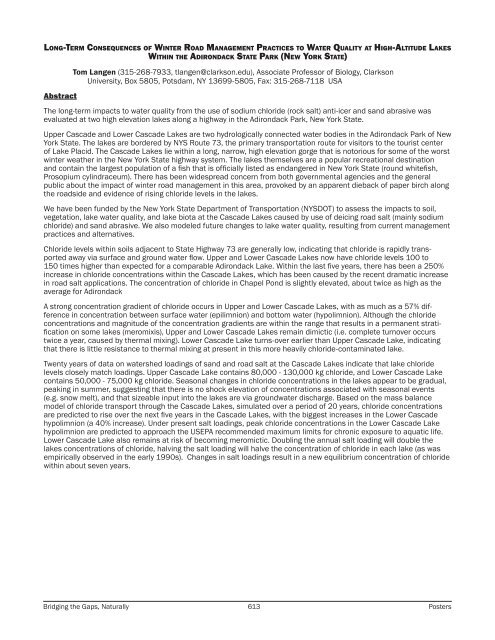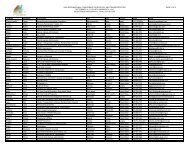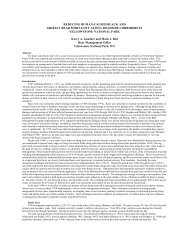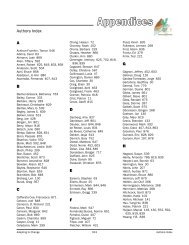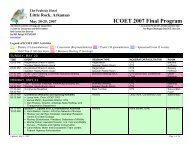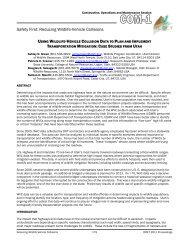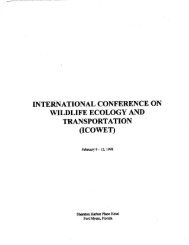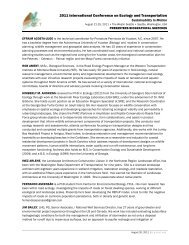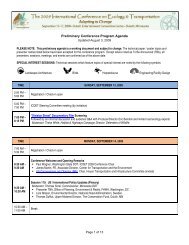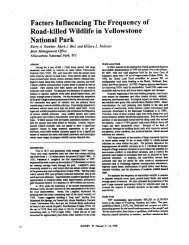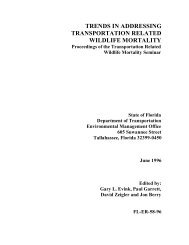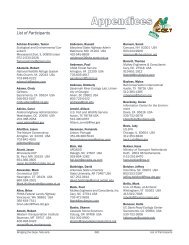Poster Sessions, pages 567-640 - ICOET
Poster Sessions, pages 567-640 - ICOET
Poster Sessions, pages 567-640 - ICOET
You also want an ePaper? Increase the reach of your titles
YUMPU automatically turns print PDFs into web optimized ePapers that Google loves.
Long-Term Consequences of Winter Road Management Practices to Water Quality at High-Altitude Lakes<br />
Within the Adirondack State Park (New York State)<br />
Abstract<br />
Tom Langen (315-268-7933, tlangen@clarkson.edu), Associate Professor of Biology, Clarkson<br />
University, Box 5805, Potsdam, NY 13699-5805, Fax: 315-268-7118 USA<br />
The long-term impacts to water quality from the use of sodium chloride (rock salt) anti-icer and sand abrasive was<br />
evaluated at two high elevation lakes along a highway in the Adirondack Park, New York State.<br />
Upper Cascade and Lower Cascade Lakes are two hydrologically connected water bodies in the Adirondack Park of New<br />
York State. The lakes are bordered by NYS Route 73, the primary transportation route for visitors to the tourist center<br />
of Lake Placid. The Cascade Lakes lie within a long, narrow, high elevation gorge that is notorious for some of the worst<br />
winter weather in the New York State highway system. The lakes themselves are a popular recreational destination<br />
and contain the largest population of a fish that is officially listed as endangered in New York State (round whitefish,<br />
Prosopium cylindraceum). There has been widespread concern from both governmental agencies and the general<br />
public about the impact of winter road management in this area, provoked by an apparent dieback of paper birch along<br />
the roadside and evidence of rising chloride levels in the lakes.<br />
We have been funded by the New York State Department of Transportation (NYSDOT) to assess the impacts to soil,<br />
vegetation, lake water quality, and lake biota at the Cascade Lakes caused by use of deicing road salt (mainly sodium<br />
chloride) and sand abrasive. We also modeled future changes to lake water quality, resulting from current management<br />
practices and alternatives.<br />
Chloride levels within soils adjacent to State Highway 73 are generally low, indicating that chloride is rapidly transported<br />
away via surface and ground water flow. Upper and Lower Cascade Lakes now have chloride levels 100 to<br />
150 times higher than expected for a comparable Adirondack Lake. Within the last five years, there has been a 250%<br />
increase in chloride concentrations within the Cascade Lakes, which has been caused by the recent dramatic increase<br />
in road salt applications. The concentration of chloride in Chapel Pond is slightly elevated, about twice as high as the<br />
average for Adirondack<br />
A strong concentration gradient of chloride occurs in Upper and Lower Cascade Lakes, with as much as a 57% difference<br />
in concentration between surface water (epilimnion) and bottom water (hypolimnion). Although the chloride<br />
concentrations and magnitude of the concentration gradients are within the range that results in a permanent stratification<br />
on some lakes (meromixis), Upper and Lower Cascade Lakes remain dimictic (i.e. complete turnover occurs<br />
twice a year, caused by thermal mixing). Lower Cascade Lake turns-over earlier than Upper Cascade Lake, indicating<br />
that there is little resistance to thermal mixing at present in this more heavily chloride-contaminated lake.<br />
Twenty years of data on watershed loadings of sand and road salt at the Cascade Lakes indicate that lake chloride<br />
levels closely match loadings. Upper Cascade Lake contains 80,000 - 130,000 kg chloride, and Lower Cascade Lake<br />
contains 50,000 - 75,000 kg chloride. Seasonal changes in chloride concentrations in the lakes appear to be gradual,<br />
peaking in summer, suggesting that there is no shock elevation of concentrations associated with seasonal events<br />
(e.g. snow melt), and that sizeable input into the lakes are via groundwater discharge. Based on the mass balance<br />
model of chloride transport through the Cascade Lakes, simulated over a period of 20 years, chloride concentrations<br />
are predicted to rise over the next five years in the Cascade Lakes, with the biggest increases in the Lower Cascade<br />
hypolimnion (a 40% increase). Under present salt loadings, peak chloride concentrations in the Lower Cascade Lake<br />
hypolimnion are predicted to approach the USEPA recommended maximum limits for chronic exposure to aquatic life.<br />
Lower Cascade Lake also remains at risk of becoming meromictic. Doubling the annual salt loading will double the<br />
lakes concentrations of chloride, halving the salt loading will halve the concentration of chloride in each lake (as was<br />
empirically observed in the early 1990s). Changes in salt loadings result in a new equilibrium concentration of chloride<br />
within about seven years.<br />
Bridging the Gaps, Naturally 613 <strong>Poster</strong>s


